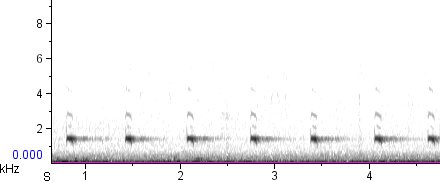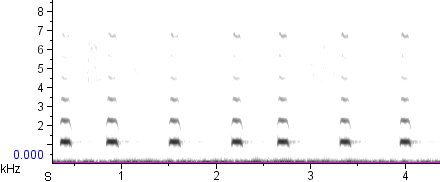Pygmy-Owl Confusion
On 12 January 2009, my friend Andrew Spencer recorded an unseen creature on Chews Ridge in Monterey County, California:

To my ear this sounds like a Northern Pygmy-Owl (sensu stricto: Glaucidium gnoma californicum), and the spectrogram shows many of the characteristics of that species. The note shape is pretty classic, with a sharp initial upslur and terminal downslur, and an overall barely downslurred trend to the rest of the note. Almost all of the energy is concentrated in the fundamental, but a couple of faint harmonics are visible, which is standard for pygmy-owls.
But a few things about this recording are strange:
- The notes are quite short, about half the length of the average Northern Pygmy-Owl note;
- The rate of the series is quite fast (on average about 1 note every 0.66 sec), which is more than twice as fast as you’d expect from pygmy-owls from California;
- The pitch of the notes is just a little high, about 1.5 kHz, while most Northern Pygmy-Owl notes fall just above 1.0 kHz;
- Oddly, Andrew reports that the sound was coming not from a tree or bush, but from somewhere on the ground. It’s unlikely that Andrew misjudged the origin of the call: he was aiming at it with a parabolic dish, and if the source of the sound hadn’t been close to the focus of the parabola, most likely the harmonic would be absent from the spectrogram and the echo would be louder in relation to the original sound.
Because the sound came from the ground, Andrew surmised that he might have recorded some kind of mammal. But what kind of mammal could sound so remarkably similar to a pygmy-owl? If there is a mammal in California that sounds like this, then I want to know about it.
I did manage to find a recording that matched Andrew’s: Doug Von Gausig made this recording in almost the same place: along the Carmel Valley Road just east of Carmel, California, on 24 March 1999. In an email, Doug told me his pygmy-owl was unseen, but positioned high within the trees in a dense gallery forest.
The bird on Doug’s recording is even higher-pitched and faster than the one on Andrew’s. Together, these two recordings represent quite a departure from what I’ve come to think of as the “typical” song of californicum. Xeno-Canto, the Macaulay Library and the Borror Lab, between them, have nine recordings of the primary song of Northern Pygmy-Owl, from California, Oregon, Montana, Colorado and Utah. None of the birds in these recordings quite match the Spencer/Von Gausig birds in note length or pitch, and most strikingly, none of them come close in rate: the Borror bird from Utah and Jason Beason’s Colorado bird average about one note every 1.5 sec, while the rest, including the Montana bird, average a note every 2.0 sec or more. At the moment, I’m still a little skeptical that “interior” Northern Pygmy-Owls sing significantly faster than “coastal” Northern Pygmy-Owls on average, but I have long agreed that “Mountain” Pygmy-Owls (Glaucidium gnoma gnoma), which breed from southern Arizona south through Mexico, sing very differently from californicum and probably deserve species status. Here’s their standard song:

In addition to the typical song with the irregular rhythm, “Mountain” Pygmy-Owls apparently sometimes give a faster, stricter song that is very similar to the song of the Northern Saw-Whet Owl (so similar, in fact, that I suspect the two may represent a vastly underrated ID problem). See the Xeno-Canto forum discussions (here and here) of Allen Chartier’s seven cuts of fast Mountain Pygmy-Owl song from Oaxaca. I was particularly struck by Rich Hoyer’s understanding of a stepwise slowing trend in pygmy-owl song rates as you move counterclockwise from Mexico to Colorado to California to Baja California Sur. Up to a point, that jives with the information I have, but what to make of the two birds from Monterey County that sing at a rate of about 80 notes/minute? Are they representatives of an anomalous local dialect? Or of a different type of vocalization than the primary song? Are they not even pygmy-owls at all?
What gives?
10 thoughts on “Pygmy-Owl Confusion”
In southern California south of the San Gorgonio Pass, we have up until only recently counted Northern Pygmy-Owls based on call only. This has not surprisingly given the species a legendary reputation. Only after completion of the San Diego County Bird Atlas (2002) did we come to grips with a rather embarrassing fact: we had been counting a bird that no one ever saw, from the days of Grinnell to now! The atlas author, Phil Unitt, published a disclosure (http://elibrary.unm.edu/sora/wb/v35n03/p0175-p0177.pdf) that implicated more than a few experienced birders. So, what did we hear? Well, likely avian culprits include Townsend’s Solitaire (call note), Mountain Quail, and California Thrasher (call note). But more likely are California Ground Squirrel and two chipmunks: Merriam’s and California. Their alarm/contact calls seem to be the preferred choice for pygmy-owl impostors among most local birders I know (at least since 2002!).
I don’t know off-hand of any website with easily accessed squirrel and chipmunk calls or spectrograms. Does anyone else?
Geoff Rogers
San Diego, CA
I have no real expertise in this area, but I do listen for owls frequently along the central coast of California and I’ve been warned that the call of Merriam’s Chipmunk can be similar to the Northern Pygmy Owl? When I researched this about a year ago, I had real difficulty finding a recording of Merriam’s Chipmunk on the Cornell or other audio database web sites, though… You may well be familiar with the calls of this mammal, however, and may have already ruled it out.
Sincerely,
Ken Schneider
Redwood City
As Geoff and Ken have suggested, confusion between vocalizations of Northern Pygmy-Owls and some mammals is a big problem in California. But I would really limit the culprit to Merriam Chipmunk (and possibly other closely related Neotamias) — California Ground Squirrels are quite different, and I don’t think anyone with experience would have trouble with California Thrasher, Townsend’s Solitaire, Mountain Quail or any other non-owl. I think the rate at which the “hoot” call of Merriam Chipmunk is given is reflective of level of annoyance/aggression/etc. on the part of the animal, though one would have to delve into the mammal literature to learn about context of this call — bottom line, it can be give fast (as in the Monterey recording) or more slowly (one note every 1-2 sec). Geoff has nailed it though — mistaking the “hoot” (or “cuck” in some mammal literature) call of Merriam Chipmunk and relatives for a Northern Pygmy-Owl is a VERY common error among birders. I know at least some of the (apparently bogus) claims of Northern Pygmy-Owl in the mountains of Riverside and San Diego Counties in California are based on vocalizations heard at night, so chipmunks are less likely to be the culprits there (perhaps the confusion was with Northern Saw-whet Owls?). As for the Chew’s Ridge, Monterey Co., recording — I believe they may well be of a Merriam Chipmunk (there is a lot of variation int he individual notes — something typical of chipmunks, but seemingly less so of the owl).
Before commenting, I would like to know in which part of California and at what time of day the recording was made.
Steve,
Andrew’s recording was made on Chews Ridge in Monterey County on 1/12/2009. I don’t know exactly what time of day it was, but it was certainly during the daylight hours, sometime before noon. He took lots of recordings of day birds immediately before and after this cut.
I think I have a new favorite blog–this is great stuff, all of it!
Best wishes,
rick
Hi Nathan –
I saved this email in hopes of listening to the sound clip some day (I have a REALLY slow internet and no flash player). Well, I finally got to it. I see that your commenters suggested a Merriam’s chipmunk and I wanted to throw in my concurrence. I have done extensive bird work in the northern Sierra Nevada and north coast ranges which collectively have several species of chipmunks. Some of my least discriminating field workers will occasionally confuse a chipmunk call for a pygmy-owl, but the chipmunks in those regions make calls that are only weakly similar to pygmy-owls. However, in June 1993 while working with Purple Martins near Anderson Peak in the Santa Lucia Range of Monterey County, I thought I heard a pygmy-owl but eventually confirmed the originator as a chipmunk (calling from a bush). It was so similar to a pygmy-owl tonally that I have never forgotten this. While I am not a chipmunk expert, Merriam’s chipmunk is the only one that fits distributionally. I have still never heard a Sierran/north coast range chipmunk give such a pygmy-owl-like call.
Thanks,
Brian
Sounds like a Northern Saw-Whet to me
Great thread. Here in the Las Cruces, NM area local birders run into this same situation in the Organ Mtns (Pine tree Trail at the Aguirre Springs Nat’l Rec Area and in Fillmore Canyon near Dripping Springs Natural Area). At these places we have the endemic Organ Mtn Chipmunk (Tamias quadrivittatus australis) the populations and distribution of which can change dramatically from year-to-year, and seasonally. The Organ Mtns are mostly pine-oak-juniper with some ponderosa pine “forest” and very limited stands of Douglas fir and even a few white fir (also some aspen and big-tooth maple, Gambel oak). N pygmy-owls are rare in the range with perhaps 5 records; there may be a few breeding pairs. We’ve all gone through the “elimination game” with rock squirrels (bark is too harsh, although some locals are fooled) and Antelope squirrels (lower elevations), but Townsend’s solitaire were found to be the culprits on a number of occasions, however only during a few winters. So who’s making the sound during the non-winter season? We focused on the chipmunk. I’ve used my p/s camera to take a few video clips of some of these sounds and have never been convinced of it being a pygmy owl, although I have a strong hunch that they do occur and breed in the range. In 2007 a friend was birding along the foothills of the western edge of the Organs in Lower Fillmore canyon (mostly desert scrub and foothills grassland)when he heard the distinctive call of a pygmy owl coming from a dense Little-leaf sumac (Rhus microphylla). That one observation we toiled over because my friend was well “down” from what we’d consider to be suitable habitat for the chipmunk, and where I’ve never encountered them. Just to add a little confusion to the mix, later that winter I did find a silent perching N saw-whet owl about 1.0mi up-canyon from this last observation. Hopefully some this local confusion might be remedied in 2010 when I hopefully will be doing an owl survey of much of the Organs….. When I was living in San Diego 1999-2003 I remember talking to Geoff (hi Geoff!) about this very topic: I had camped in the Laguna Mtns and heard what I told Geoff was a N pygmy-owl calling form near my camp…I believe he suggested N saw-whet owl…. An let’s not forget that we also need to consider the diurnal vs nocturnal aspects of all the possibilities (I’ve not know a chipmunk to call during the night, although I’ve heard many, many different bird species calling)
Thanks,
David
Comments are closed.